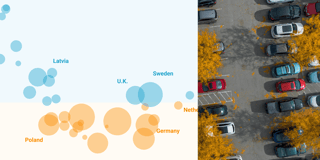The only chart we should be looking at
Hi, this is Gregor, and I’m Co-Founder and CTO of Datawrapper. I’m kicking off our new Weekly Chart rotation that Lisa mentioned last week.
At her speech at the British Parliament on April 23, Swedish climate activist and initiator of the FridaysForFuture movement, Greta Thunberg said
“People always tell me and the other millions of school strikers that we should be proud of ourselves for what we have accomplished. But the only thing that we need to look at is the emission curve. And I’m sorry, but it’s still rising.”
So for this episode of our Weekly Charts I want to listen to Greta and show the curve she is talking about, which shows global carbon emissions1 since 1959:
And as we see, the emissions are indeed still going up. The Global Carbon Budget project estimated that the 2018 emissions increased about 2.8% over 2017. But where does this increase come from?
To help the reader answer the question I decided to combine the line for total Carbon emissions with stacked areas for different countries and Europe. It indicates that most of the increases since 2000 are coming from China and countries outside Europe and the U.S. But as with any stacked area chart, it is hard to compare how the individual areas changed because they don’t start at zero.
An alternative way to plot the different regions is a baseline chart. Instead of plotting the emissions, the chart shows how the emissions changed compared to the base year 2000.
Here we can see that since 2000 the carbon emissions have trippled in China and more than doubled in India. We can also see that between 2013 and 2017, the increase had stopped in China. And while emissions did decrease in Europe and the U.S., the chart clearly shows that no further progress has been made over the last five years.
At this point it is important to mention a well-known flaw in this dataset: Rich countries have notoriously managed to “outsource” their emissions to China. A lot of the increase we see is being caused by goods like smartphones and cheap clothes, which are being manufactured in East Asia but are consumed in Western countries.
Finally, there is another important thing missing in the emission curve, and that’s where we need to be heading. The October 2018 special report of the Intergovernmental Panel on Climate Change (IPCC) stated that in order to limit global warming to below 1.5 degree Celsius we need to reach net-zero emissions between 2045 and 2055.
Without showing this goal in the emission charts, even a slight reduction in emissions may look like a big achievement, while the truth is that it’s not. Or, as Greta has put it in her speech:
“The fact that we are speaking of “lowering” instead of “stopping” emissions is perhaps the greatest force behind the continuing business as usual.”
Let me know if you have feedback. Feel free to use these charts in your own articles. You can find them in our River. If you’re wondering how I created the red area in the last chart, I used a new feature we just launched this week.



